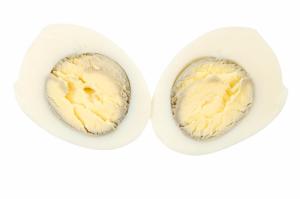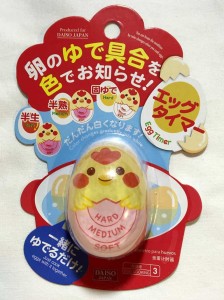
Overcooked egg
A few years ago, I bought a cookbook called Kulinarya: A Guide to Philippine Cuisine (ed., Michaela Fenix, Anvil, 2008). Gorgeously photographed by Neil Oshima, Kulinarya is a distillation of the wisdom and know-how of six of the country’s top chefs: Glenda Rosales Barretto, Conrad Calalang, Margarita Forés, Myrna Segismundo, Jessie Sincioco and Claude Tayag (who also served as food stylist for the volume).
Included are recipes of such Filipino standard fare as dried beef tapa, pork barbecue, kinilaw na tanguigue, kaldereta, tinola, bulalo, pinakbet, cripsy pata, kaldereta, pan de sal, halo-halo, and an enticing assortment of ensalada, sinigang, adobo, relleno, pancit, merienda (snacks), and desserts.
In one of the essays in the introductory section, entitled “Working Towards World-Class Cuisine,” the authors state that the mission of the collaborative Kulinarya Project is “to inspire world-class preparation and presentation of Filipino food.” The aim of the recipes, according to the book, is to “define tradition, not reinvent it.”
The book emphasizes the importance of using quality ingredients—liempo with evenly distribued fat-to-meat content, lechon that uses native pigs, prawns weighing at most 50 grams, 500-gram bangus for relleno—as well as storing food at the proper temperature, serving food that is “freshly cooked and piping hot,” and making sure that the vegetables are not limp and leached of their color.
The cookbook is a joy to read and sample, except for one small but nevertheless telling detail. Nestled in the ensaladang Filipina (Filipino salad), with its mouth-watering array of steamed okra, kamote tops, and water spinach, its grilled and skin-charred eggplants, and its dressings (ranging from guisadong bagoong alamang or sautéed shrimp paste and guisadong bagoong isda or sautéed fish paste to sweet-and-sour vinaigrette and honeyed fish sauce), are slices of hardboiled eggs that bear the unmistakable, telltale signs of overcooking.
You can tell that an egg is overcooked when there is a greenish-gray ring around the yolk. The ring is basically ferrous sulfate, the product of a chemical reaction between the sulfur from the egg white and the iron from the egg yolk. While the ferrous sulfate ring is not toxic, it does affect the look and taste of the egg.
To be fair, other photographs in the book feature perfectly boiled eggs in the rellenong manok (chicken deboned and stuffed with Vienna sausage, chorizo, onions, pimiento, olives, raisins, boiled eggs, Edam or Parmesan cheese, and ground pork) and the pancit luglog (rice noodles with a sauce made of annatto oil, garlic, shrimp stock, and chicken stock, seasoned with fish sauce and pepper, and topped with kamias [bilimbi], chicharon [pork crackling], smoked fish flakes, squid rings, pork meat, scallions, and toasted garlic).
In recent years, Filipino cuisine has garnered international recognition for its rich and varied culinary tradition and its creative appropriation of ingredients and cooking techniques from different parts of the world, both East and West, North and South.
Pointing out an overcooked egg or two is not mere quibbling. A close-up of one such wedge of egg right next to the “Working Towards World-Class Cuisine” essay undermines the stated mission of promoting a “world-class cuisine.” If a picture is worth a thousand words, then a badly cooked egg does nothing to enhance our pleasure and pride in our food history and culture.
To put it bluntly, how can we trust our best cooks to “define” Filipino culinary tradition and present the best of our food culture when some (thankfully not all!) of them cannot even boil an egg properly?
This is not some freak occurrence, either. I have seen YouTube videos of professional chefs (whose names are best left unmentioned) demonstrating the art of making, say, rellenong manok for Christmas. The relleno looks delicious, except, alas, for the overcooked eggs.
This suggests either negligence or lack of oversight (should these chefs rely on assistants to do the preparation for them) or, worse, lack of basic knowledge, training, and skill. The kindest thing that can be said about the cooks who serve badly cooked eggs is that they are too lazy to maintain the minimum standards of cooking; the worst that can be said is that they simply don’t care about the people for whom they cook.
And yet, reasonable instructions for boiling eggs properly can be found in no-nonsense, workperson-like cookbooks. For example, Eleanor Laquian’s Filipino Cooking and Entertaining Here & Abroad (National Book Store, 2007; earlier editions of the book were published under the title Filipino Cooking Here & Abroad)—a favorite of OFWs because its recipes have been adapted to cooking in places where not all native ingredients such as kalamansi or patis are available—contains the following tips for hard cooked eggs:
“Place eggs in a pot, cover with cold water, bring water to a boil, immediately remove pot from heat on boiling. Keep pot covered, let stand for 20 minutes.”
Laquian even offers a contingency plan for people who let their water come to a boil without having put in the egg beforehand. She suggests lowering the egg into the water with a metal spoon “so metal absorbs the heat and eggs won’t crack from the sudden change in temperature”. The temperature should be lowered so that the water gently simmers: “Never boil eggs, they become rubbery”. For hard-cooked eggs, allow 10 minutes, for medium-cooked eggs, 3-4 minutes. If eggs are not at room temperature before they are cooked, add 2 minutes more to the cooking time.
Timing is not all. How eggs are handled immediately after cooking is equally crucial: “Never let cooked eggs stand in the hot water after cooking, this toughens the egg white and makes it difficult to peel the eggs.” Instead, rinse the eggs under cold running water, or else plunge the eggs into cold water as soon as they are cooked.

Daiso’s egg timer
In Japan, Daiso’s 100-yen shops sell egg timers which can be put into the pot along with the eggs. These timers turn pink to indicate “hard,” “medium,” and “soft” boiled egg.
Other cookbooks recommend cooking times of 10 minutes for hard, 5 minutes for medium, and 2 for soft. Perfectionists that they are, some Japanese chefs also suggest using chopsticks to gently roll the eggs in the water as the water is being heated to ensure that the yolk stays in the middle of the egg.
If we want to affirm the wonders and pleasures of Filipino cuisine to ourselves and introduce properly our cuisine to the world, we might as well start by cooking our eggs properly.





